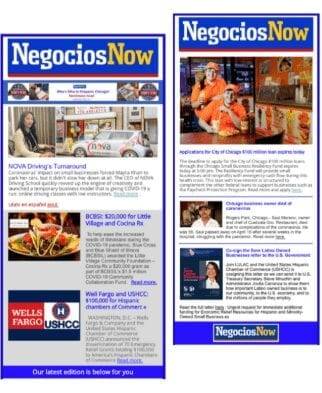Interview with Illinois State Treasurer Michael Frerichs about the Illinois Secure Choice retirement program.
By David Steinkraus

He also talked about a solution: the Illinois Secure Choice retirement program and the accompanying law that set a series of deadlines for companies to offer a retirement savings program to employees. Secure Choice has been rolled out in three phases, beginning with the largest employers. This fall brings the enrollment deadline for the smallest employers.
Illinois Treasurer Michael Frerichs
Businesses that have existed for at least two years, and that had five to 15 Illinois employees in 2022, must offer a qualified retirement plan or start the onboarding process for Secure Choice by Nov. 1. Companies with 16 to 24 Illinois employees had to be signed up by Nov. 1, 2022.
“Everyone knows they need to save for retirement,” Frerichs told Negocios Now. “Life happens, excuses come up, and we put this off. We all know this.”
People want to save, but they face other expenses: holiday gifts, vacations, credit card debt, and unexpected bills, he said. Retirement planning also requires finding a financial advisor and thinking about how much risk to take with retirement investments, and so people delay saving, he said. Then people reach their 50s or 60s and haven’t saved for retirement, and they may feel like failures and may be embarrassed to talk about it, he said.
Automatic contributions
Secure Choice gives workers their own Roth IRA. These are funded with after-tax dollars, and withdrawals are tax-free. A seven-person board, with the state treasurer as chair, oversees the program. Professional investment managers are hired to administer the program.
A big advantage of Secure Choice, Frerichs said, is that contributions are made automatically through payroll deductions at a default rate of 5% that employees can change. To date, more than 120,000 workers have enrolled in Secure Choice and saved more than $100 million, according to Frerichs’s office.
Because of the federal Employee Retirement Income Security Act, Frerichs said, employers are forbidden from making contributions, which also means they carry no liability for management of the funds and pay no fees.
“It’s not that employers aren’t interested in helping their employees to save for retirement,” he said. “Employers know that happy employees are more productive employees.” People with worries are less productive, he added.
For smaller employers, like the group facing the November deadline, setting up a private retirement program can be difficult and complex.
Savings gap
In September 2022, the American Association of Retired Persons reported that about 64% of Latino employees ages 18 to 64 did not have access to a workplace retirement plan. More than 53 percent of African American employees did not have access while 42% of white workers and 45% of Asian workers didn’t have access, AARP reported. In past work, AARP researchers found that Americans are 15 times more likely to save for retirement if they have a workplace plan and are 20 times more likely to save if contributions are automatic.
Businesses that do not comply with the law may be referred to the Illinois Department of Revenue for enforcement. Penalties are $250 per employee for the first calendar year of noncompliance, and $500 per employee for each subsequent calendar year of noncompliance.
The Revenue Department has begun enforcement for noncompliance for the enrollment periods from 2018 through 2020. “Right now we have been much more interested in communicating and signing businesses up,” Frerichs said.
Secure Choice is focused very much on employees, Frerichs said, but employers also benefit. They don’t pay fees or make contributions, he said, and employers who worried about the cost of administering the program find it’s rarely more than an additional column on a spreadsheet, a minor change in payroll tax and other payments they already send as part of the payroll process.
Then those businesses realized they could use Secure Choice as a recruitment and retention tool, he said.











